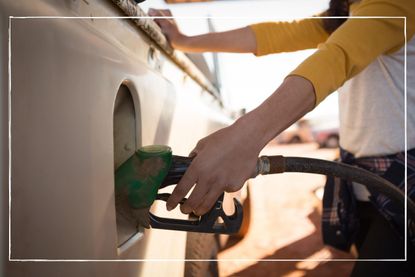Cheapest fuel - how and where to find cheaper petrol and diesel
We explain how drivers can find the cheapest fuel as the cost of living crisis continues to bit

Find the cheapest fuel as the cost of living crisis continues to bite.
British households spent 66% or £226 more on petrol in 2021 than in 2020, according to the latest figure by insurer LifeSearch - and prices have risen further this year. Chancellor Rishi Sunak has announced a year-long 5p cut to fuel duty to help drivers save money on fuel. But still, the average price of a litre of petrol has risen by more than 40p since March 2021.
Even if the cut is passed on at the pumps, motorists may fail to feel the benefit. A recent RAC report found someone with a typical 55-litre car will save just £3.30 when they go to the petrol station. Using fuel loyalty cards (or even supermarket loyalty cards) can help to keep costs under control. Practising all the ways you can make your petrol or diesel last longer is also key. But knowing the savvy ways to find the cheapest fuel is essential to keeping fuel costs as low as possible.
How to find the cheapest fuel
There are several websites and apps that can help you find the cheapest fuel, including PetrolPrices.com, Waze, and Petrolmap.co.uk. While you may need to register, these tools are free to use. You could save hundreds of pounds each year. Here's how they work:
Petrol Prices This site claims it can save more than £220 a year for each of its two million users. It does this by comparing petrol and diesel prices at the cheapest or nearest petrol station. If, for example, you buy super unleaded petrol for your car, it claims you could save £495 a year; diesel motorists could save £289 a year. Visit the site
Waze This traffic app crowdsources fuel prices for its live map. To find the best petrol prices tap the 'Where to?' box. You’ll see your location history, and, among other points of interest, petrol stations. Select the petrol station icon to reveal a list of them in your area. You'll also see the price of petrol, the distance to each petrol station, and their addresses. The prices are helpfully colour-coded, from green to red in order of least expensive to most. Visit the site
Petrol Map You can join petrol comparison website Petrolmap for free. It claims it saves its users an average of £200 a year. Prices are updated daily. You can also create price alerts to ensure you never miss out on the best prices near you. You can filter by fuel type, distance and fuel brand, and there's also a useful route planner too. Visit the site
GoodtoKnow Newsletter
Parenting advice, hot topics, best buys and family finance tips delivered straight to your inbox.
Confused.com This well-known website has a new tool that reveals the top five cheapest petrol stations in your area. After setting up a free account you put in which fuel you want and your postcode. You can use the tool without setting up an account - but it will only let you search petrol prices once a day and only show you the cheapest petrol station in your area, and not other options near you. Visit the site
Local news websites In addition, any regional news websites provide updates, sometimes on a daily basis, on the cheapest places to fill up your tank. For example, Birmingham Mail outlines which petrol stations are the cheapest in the West Midlands while Devon Live reveals the cheapest petrol and diesel prices across its county.
Do supermarkets always have the cheapest fuel?
No, but research suggests supermarkets do very often have the cheapest fuel. Supermarkets are usually about 3p per litre cheaper than the UK average price, according to Carwow, an online platform for buying new and used cars. Petrol is also generally cheaper in towns and cities than in rural locations. But supermarkets - even those in the countryside - are often still cheaper than oil-firm-owned petrol stations in cities.
Tradesure Insurance's John Wilkins told us: “AA data also suggests that supermarkets tend to have cheaper prices than average but this may not always be the case, so drivers may still need to look around their locals before deciding where to buy.”
Is it worth driving further for cheaper fuel?
It’s only worth driving further for cheaper fuel if the extra mileage isn’t excessive. John Wilkins from Tradesure Insurance says: “If you’re doing a 10-mile round trip for 1p off per litre, that’s probably not good economic sense. If, however, you’re taking a 2-mile detour on your way home from work to fill your tank for significantly less, then by all means drive that bit further to take advantage.”
How to spend less on fuel
- Sign up for a fuel chain loyalty scheme where you can collect points to use against future petrol purchases. For example, BP’s BPme scheme gives drivers one point (worth 0.5p) per litre of regular fuel they buy and two points (worth 1p) per litre of Ultimate range petrol. Texaco’s Star Rewards gives drivers one point (worth 1p) for every litre of fuel bought. Shell’s Shell Go+ gives drivers who spend £10 or more on fuel a “visit” which totted up to 10 “visits” will allow them to claim money off their fuel purchase.
- Take out a supermarket loyalty card to get points that will eventually convert to money off a tank of fuel. For example, Sainsbury’s customers can collect a Nectar point (worth 0.5p) for every litre of fuel they buy. If you have a Tesco Clubcard you’ll earn 1 point for every £2 you spend on petrol.
- Use cashback to get a contribution to fuel costs. For example, as long as you spend at least £3,000 a year, the Platinum Cashback Everyday fee-free card offers 5% cashback for the first three months (maximum £100), then 0.5% cashback up to £10,000.
- Consider a car-sharing scheme. Carpooling with a colleague to get to work could halve your fuel costs. Liftshare, the UK’s biggest car sharing community, is free to join and claims its members save over £1,000 on average each year. ZipCar and Enterprise let you pay a monthly fee to rent a car by the hour or the day.
- Keep your car clutter-free at all times - extra weight in the boot or on the roof contributes to a higher fuel consumption
- Stop leaving your car engine running unnecessarily while it’s stationary - it costs 3-4p of fuel a minute this way which can add up to £166 a year.
- Avoid premium fuel. There’s little benefit in choosing super unleaded over normal unleaded even though the former will cost you a few pence more per litre.
- Check your tyre pressure once a month. Under-inflated wheels contribute to higher fuel consumption. Your car’s handbook will detail recommended levels.
- Be a conscientious driver. Professional racing driver Rebecca Jackson is an expert on driving economically and told the RAC: "Accelerating from being stopped is very costly in fuel consumption terms and so is going up any steep incline. If you can keep moving slowly rather than stopping in traffic that’s good, but you do have to be conscious of not being a pain to other drivers by leaving too much of a gap behind the car in front. You need to listen to the engine to make sure you don’t use excessive revs but you need to use enough, so it’s a fine balance as you don’t want the car to be labouring too much either."
Video of the Week
-
 Worried about your teen 'being smelly'? They can't help it, according to scientists, and help is on its way to ease the problem
Worried about your teen 'being smelly'? They can't help it, according to scientists, and help is on its way to ease the problemWe know that puberty can cause all sorts of smells to emanate from teens - now scientists have revealed exactly what you're smelling, and how evolution contributed.
By Lucy Wigley Published
-
 Parenting coach shares 4 'powerful' reframes to try next time it feels like your kid is pushing all your buttons (and #4 is a game changer)
Parenting coach shares 4 'powerful' reframes to try next time it feels like your kid is pushing all your buttons (and #4 is a game changer)A parenting coach has shared four ways parents can reframe their thoughts when their kid has big emotions. Giving them a try could offer big results in little time.
By Lucy Wigley Published